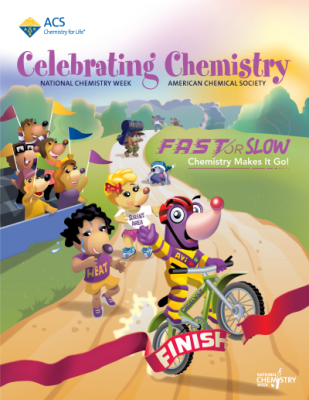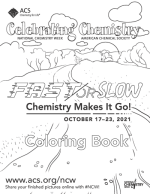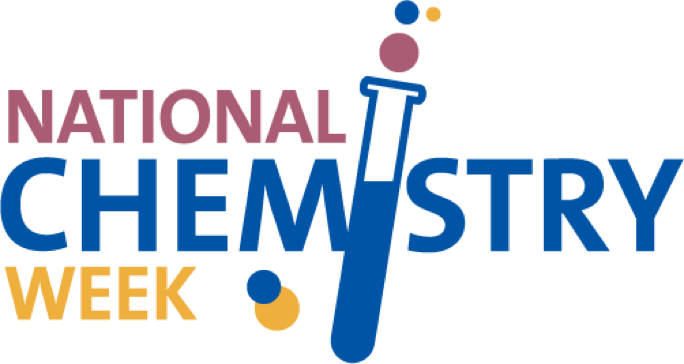NCW 2021 Celebrating Chemistry
Fast or Slow ... Chemistry Makes It Go!

In this issue
Articles
Fast or Slow ... Chemistry Makes It Go!
Everything around us is made of molecules. Molecules are in constant motion, and when they collide just right, chemical reactions can occur! Chemical reactions can happen fast or slow, and the reaction rate comes down to molecules.
Enzymes: Moving at the Speed of Life
All living things depend on millions of chemical reactions that happen constantly. Chemical reactions that keep you alive happen fast, and enzymes speed up these important reactions!
Need Clean Air, Quick? Catalytic Converters to the Rescue!
The gasoline and diesel cars use creates exhaust, which contains many different gases that pollute our air and water. Chemists invented a device called a catalytic converter to quickly break down car exhaust into less harmful materials.
That's One Fast Reaction!
Modern cars have airbags built into the dashboard and steering wheel that can blow up like super-fast balloons during a collision, and cushion riders from getting hurt. A very fast chemical reaction makes the airbag blow up like a balloon.
Meg A. Mole Interview with Dr. Francisco Zaera
Meg A. Mole, Future Chemist interviews Dr. Francisco Zaera, Professor of Chemistry at University of California, Riverside.
Dynamite and the Ethics of its Many Uses
When discovering new ideas, scientists are guided by ethics. You can think of ethics as being able to decide whether an idea or action is right or wrong. Does an invention help people or hurt people? Can an invention do both? Look at one example: the invention of dynamite by Alfred Nobel.
Activities
Chemistry Goes Pop!
Do a simple experiment with a package of Pop Rocks® to look at the ways temperature affects how quickly the gas escapes the candy.
Slowing Apple Browning
Many people find fruit slices with brown spots to be less appetizing. This browning is due to a chemical reaction with oxygen in the air. Test different ways of slowing down browning in fruit through chemistry.
Slow the Glow
When you bend a light stick to activate it, chemicals mix, react, and glow! Do you know how to slow the glow so that the light lasts longer? This activity holds the key.
Fizz Race
Let’s see how you can make the fizzing reaction of Alka-Seltzer tablets go faster and slower. We can monitor the formation of carbon dioxide by hearing the fizz and seeing how long it is produced.
Extras

Coloring Book (PDF)
Download and print these fun coloring pages featuring the moles and artwork from this edition of Celebrating Chemistry! Share your finished products on social media with the hashtag #NCW.

NCW 2021 Theme Team
- Lori Stepan, NCW Chair
- Dave Heroux, 2021 Co-Chair
- Cary Supalo, 2021 Co-Chair
- Avrom Litin
- David Katz
- Keith Krise
- Kenneth Fivizzani
- Regina Malczewski
- Sara Delgado-Rivera
- Tracy Hamilton
- Veronica Jaramillo
- William Doria
Production Team
- Allison Tau, Editor
- Eric Stewart, Copyeditor
- Michael Tinnesand, Copyeditor
- Rhonda Saunders, Designer
- Jim Starr, Illustrator
- Andrés Vergara, Translator
Technical and Safety Review Team
- Lynn Hogue, Consultant
- Bettyann Howson, Safety Reviewer
- Ashley Neybert, Accessibility Reviewer
- Sara Delgado-Rivera, Translation Reviewer
Division of Education
- LaTrease Garrison, Executive Vice President
- Lily L. Raines, Manager, Science Outreach
- Allison Tau, Program Specialist, Science Outreach
Words to Know
Activation energy – the minimum amount of energy needed for a chemical reaction to proceed.
Atom – the smallest unit of a chemical element that has the characteristics of the element.
Catalyst – a substance that helps a chemical reaction go faster, but does not undergo any permanent chemical change itself.
Catalytic converter – a device in gasoline-powered cars that catches pollutants in a car’s exhaust and changes them to less harmful substances.
Chemical bond – forces of attraction between atoms or molecules that create compounds.
Chemical reaction – the process of rearranging atoms between substances to make different substances.
Chemistry – the study of matter, its properties, and its changes.
Collision – when a moving object strikes against another object; in chemistry, the objects are atoms and molecules.
Decomposition – a type of chemical reaction in which a substance breaks down into simpler parts.
Element – a pure substance, such as copper or oxygen, made from a single type of atom. Elements are the basic building blocks of all matter.
Energy – what makes things change and move. All changes are caused by energy, and there are many types, including wind, chemical, or electrical energy.
Enzyme – a molecule in living things that acts as a catalyst.
Heat – a form of energy created by the vibration of atoms and molecules.
Molecule – the smallest unit of a chemical compound. They are made from two or more atoms.
Phase of matter – describes whether a substance is solid, liquid, or gas.
Product – a substance produced at the end of a chemical reaction.
Reactant – a substance that is part of a chemical reaction and is changed by it.
Reaction rate – the rate at which a chemical reaction proceeds.
Surface area – the amount of space covering the outside of an object.
Acknowledgments
The articles and activities used in this publication were written by theme team members of the ACS Committee on Community Activities (CCA) under the leadership of Holly Davis. Meg A. Mole’s interview was written by Kara KasaKaitas.
The activities described in this publication are intended for children under the direct supervision of adults. The American Chemical Society cannot be responsible for any accidents or injuries that may result from conducting the activities without proper supervision, from not specifically following directions, or from ignoring the cautions contained in the text.
References
- Fruits Gone Bad? Discover Enzymatic Browning: STEM Activity
- Chemistry in the Toy Store
- Determination of the Volume of CO2 in Pop Rocks®
- Pop Rocks (Fizzy Candy)
- Apple Browning: A Study of Oxidation of Foods
- Alfred Nobel – his life and work
- Size vs. Rate of Reaction, Bayer,
- Temperature vs. Rate of Reaction, Bayern
- Plop, Plop, Fizz Fast: The Effect of Temperature on Reaction Time
- An Introduction to Kinetics Using Alka-Seltzer
- Plop, Plop, Fizz, Fizz, Limiting Reagent and Determination of NaHCO3 in Alka Seltzer Tablets

